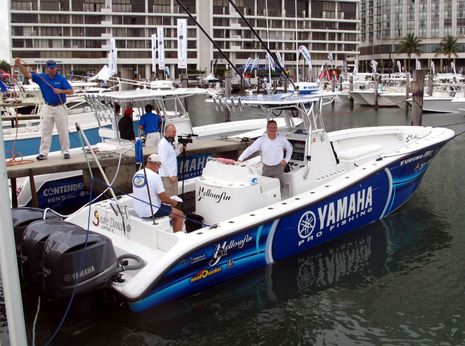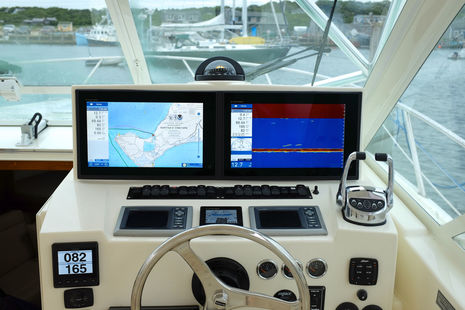Furuno at MIBS 2013; CHIRP, FCV587/627, and NavPilot FPS8
When I was at the in-water powerboat portion of the Miami show before it opened one morning, I discovered Furuno marketing manager Jeff Kauzlaric and product manager Eric Kunz making video. Of course I interrupted them for a photo but I was also hoping to see their long-rumored CHIRP fishfinder in action. But while it turned out that the big sonar screen behind Eric was not showing CHIRP, Furuno did announce the new DFF1-UHD during the show and Eric showed me the nifty NavPilot Safe Helm and Power Assist modes just about ready for release…
The best place to learn about the DFF1-UHD is at NavNet.com, which makes sense at it joins the other three black box fishfinders that work exclusively with NN3D and TZTouch. You’ll see that apparently Furuno is using CHIRP — “The equivalent sound energy transmitted into the water can be up to 1,000 times greater than a conventional fish finder” — for more than just the amazing fish arch detail seen on the TZT screen below…
The DFF1-UHD also includes, and probably refines, a Furuno feature called Accu-Fish that can purportedly analyze individual fish sizes, as well as the Bottom Discrimination Display (BDS) that was once only seen in its highest-end sonar like the BBDS1. Accu-Fish and BDS have also come to the new FCV627 and FCV587 versions of the company’s standalone fish finders, and the features are shown well in their product photography…
So on the FCV587 screen above the Bottom Discrimination is in “graphic” mode and indicating a combination or alternation of gravel and mud bottom. I think I’d prefer the “probability” mode seen below, which trades the graphics for a chart of detected bottom material types. And if you don’t like the goggle-eyed fish icons, I’m pretty sure you can eliminate them and have guesstimated fish lengths only or just the original sonar returns. Furuno almost invariably gives a user lots of flexibility.
I certainly saw that maxim at work on the various Safe Helm and Power Assist set up screens that Eric Kunz showed me. The features will come as part of a Furuno NavPilot FPS8 hydraulic pump accessory that first previewed on Panbo in 2011. Once the new 700 series software is released, an owner or installer will be able to adjust just how much helm motion it takes to disengage the pilot and just how long before a steady helm reactivates Auto or Nav modes. We didn’t actually get underway in that big triple-Yamaha Snake Dancer, but Eric demonstrated how the Power Assist could be adjusted to easily turn all that outboard weight with variable amounts of wheel turn, and much more. Furuno, incidentally, doesn’t think that their FPS8 hydraulic sensing system violates the patent Garmin has on Shadow Drive, but has apparently gotten its own patent, so unfortunately we may not see Shadow Drive/Safe Helm features on other autopilot systems.



















Ben, I’m a little confused about the Furuno’s DFF1-UHD’s capabilities. It looks like from their literature that the BSD, and Accu-Fish features are only available if you’re using a traditional 50/200kHz transducer. Do you think that is the case?
Bill, I don’t see anything like that in the literature; please point us to what you found.
Ben, here it shows the UHD with Accu-Fish and BSD, but with standard 50/200 ducers. There is the word (Advanced) next to them
http://furuno.com/en/business_product/pdf/marine/dff1uhd.pdf
Here it shows the same thing, again with 50/200 ducers.
http://www.navnet.com/network/fish_finder/index.html
In both cases it seems to indicate these features are for 50/200 ducers only. It may be that these features weren’t designed to work with CHIRP, or at least yet.
Bill, when they spec a “Dual frequency 50±20 & 200±25 kHz” transducer, I believe that is a broadband ducer capable of CHIRPing from 30-70 and 175-225 kHz. From the press release:
“The DFF1-UHD TruEcho CHIRP Fish Finder transmits and receives pulses across a range of 90 frequencies (50kHz +/- 20kHz, 200kHz +/- 25kHz) within each transmission.”
So I think that DFF1-UHD does CHIRP, BDS and Accu-fish all at once.
Thanks Ben, I see what your saying, and I’m not arguing, but it seems a confusing way to state it. Their brochure shows the Airmar 265 family of transducers being used which CHIRP’s from 42-65kHz low and 130-210kHz high, It doesn’t seem to correlate with the way they stated their specs.
Do you think Furuno can match Raymarine Evolution on autopilot?
I need to decide before summer… 🙂
The plan is to go for Raymarine Type 3 and the new Evolution, but according to my Furuno Navnet 3D system I have, it sounds more logically to choose Furuno…
What do you think? ( my Raymarine type 2 I have today is not strong enough ! )
Rolf, we have just installed a new Furuno Navpilot 711 with fantum feedback on a 25 foot fibreglass hard top and it is AMAZING!
on sea trial we were doing 35 knots with a 15 knot cross wind and 2 foot of short sea chop was no issue at all boat steered very well. Combined with a TZT9″ and utilising ACCU-FISH on the sounder, we were using the pilot to navigate back to fish targets from the sounder history.
This is what worry me choosing Furuno:
http://www.newmorning.info/page12/page23/page26/page72/page72.html
Our first season we used a Furuno course computer with a pair of AccuSteer linear hydraulic drive units. In short, that was not a good solution. The Furuno autopilot would not hold course, particularly off the wind, and the AccuSteer drive units failed repeatedly. They were both replaced over the summer of 2009.
We are now using a Raymarine SPX30 course computer and Raymarine Type 3 hydraulic linear drive units. We have an ST6002+ wired controller and S100 wireless controller. We used a Raymarine autopilot on our previous boat and were very happy with its performance and reliability.
Hi Rolf,
I too was surprised when Russ Irwin changed autopilots on New Morning. But I recall that Russ was an early adopter of several Furuno products and didn’t seem to have the patience to make that a good experience. At any rate, Furuno has had a lot of time to work on its AP technology since 2008, and I’m sure they have.
My overall sense is that modern sensors, processors, and control logic mean that all the majors are making autopilots that generally work well. And often there are some dividends that come ‘free’ with using an AP of the same brand as your primary navigation system.
But that said I’d think that anyone with hydraulic steering might be interested in the Safe Helm and Power Assist features Furuno has come up with. Then again the Raymarine Evolution with a sensor/course computer that needs no calibration, can be mounted most anywhere, and purportedly perfects itself continuously seems intriguing.
But I don’t know how you’ll ever know which AP is best for your boat (unless you try both). Good AP comparisons are rare and invariably subjective at least to the boats involved. The folks who probably know the most about comparative performance are company product managers and engineers, and they tend not to talk up the competition 😉
Thanks for the answer !
I see the Raymarine Type 3 hydraulic linear drive has a peak thrust on 1200kg.
http://www.wmjmarine.com/stpack10.html
I cannot find something to compare from accu-steer….?
Is it the LA100 that is a “type 3” comparing to Raymarine specification?
http://www.starmarinedepot.com/Accu%2DSteer+LA100D+Hydraulic+Linear+Actuator+Drive.html
For information:
The Accu-Steer LA17 model has a max thrust on 475 kg. ( Similar to Raymarine Type-2 )
So Raymarine Evolution, together with a Type-3 hydraulic linear drive, will be my next Autopilot !! ( sorry Furuno )